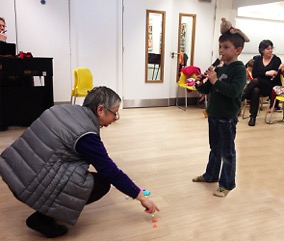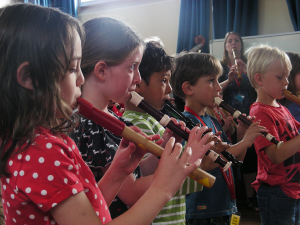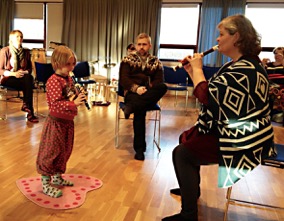← All Blog Entries
Back to Basics
Inspired to learn a very different approach to recorder teaching
– by Alyson Elliman.
Readers of The Recorder Magazine may have battled with trying to change public opinion about the sound of massed descant recorders playing at an elementary level, and about the value of continuing studies to a proficient or even professional level, rather than using it as an entrée to what some consider to be a ‘proper’ instrument. The success of two teenagers in winning the BBC Young Musician of the Year woodwind finals recently will hopefully have inspired a rethink; and introduction to the whole family of recorders, with the inherent potential for exciting ensemble work, may well have prompted an upsurge in interest.

Alyson teaching
Who wants to inspire and improve recorder learning, general musicianship and other skills, in a fun environment suited to the individual needs of the child? Of course we all do. But quite to my surprise, reading Nancy Daly’s article in The Recorder Magazine (Winter 2013) started me on an unexpected journey to become a recorder teacher.
Whilst there are many teachers in the UK and abroad using the Suzuki method for strings, piano, flute and some brass, recorder teachers are few and far between and often over-subscribed.
Looking at the Suzuki training from the perspective of a trainee, I can say that I have gained immense pleasure from the course so far (having recently completed my first year and passed the Level 1 exam, with potentially four more levels to go!). It is not necessary to do all five levels to be a recognised Suzuki teacher, but most trainees do complete at least the first two levels. You are only qualified to teach to the level you have achieved.
What do you need to embark on this course? Attending an Introductory Day is a good way to find out if the method appeals to you. There is an audition (via panel presentation or by submitting a recording of your pieces) and discussion of your background and aspirations.
For the audition, you have to play two contrasting movements of a Handel sonata, plus one other piece of your own choice. You are encouraged to play one of these pieces without music, if possible, as the method for learning is initially an aural one. The children are introduced to the basics of music reading via games, in parallel with learning the carefully structured repertoire by ear.

Summer School
Some elements you need to consider before embarking on the training course include:
- a willingness to go back to basics
- an ability to look at things from a child’s perspective
- time for attendance at training sessions throughout the year (usually two weekends per term plus two national three to five day courses)
- outlay for costs of the course, travel and training materials
Provided at the courses are:
- a supportive environment
- opportunities to perform memorised pieces in front of the tutor and peers
- supervised teaching practice
- development of group lesson techniques
- tutorials to support the understanding of Suzuki’s philosophy of learning, beginning with the Mother-Tongue approach
As adults we may be more nervous about performing, but children taught in this way are comfortable, as they have experienced a variety of opportunities to build their confidence in ‘sharing’ music with others.
How did the training fit in with my working life as a doctor? I had been eligible to retire for five years, but enjoyed my work. I had considerable experience of teaching medical students and postgraduate doctors and nurses. I had promised myself that I would only step down or reduce my hours when I found something that sparked my interest sufficiently. After being accepted on the course, I continued to work full time for six months. But I did find it challenging to fit in the initial preparation, the summer school training and all the necessary follow-up work, and so I reduced my hours. Comparing notes with others who were still working full-time throughout the year’s course, I was glad to have made the space to focus more on the training.

Teacher Training
Having only played from music before, I found the greatest challenge was to memorise a piece for the audition, and overcome the nerves that performance has always engendered. Perhaps rather ambitiously I chose to do this with a highly chromatic slow movement of a Telemann sonata, which I had played many times before. Developing my aural memory required intensive listening to recordings. The muscle and articulation memory required extensive repetition to truly internalise the work. Rather surprisingly, having mastered memorising this difficult piece, I then found it much harder to do the same with the short, but unfamiliar folk tunes that make up around half of the Level 1 repertoire. The repertoire is built up in a step-wise way, with constant review of previously-learnt pieces in a logical progression.
Our weekend sessions were held alongside flautists and string players, and I loved meeting all the other trainees and sharing experiences. I found I was far from unique in working in a sphere other than music. Having the opportunity to work with Suzuki students and their parents at the training events allowed much self-reflection about what works well and not so well. My three year old granddaughter has often said to me (apropos of other things) ‘Granny, you talk too much’. As this was also highlighted in my feedback after teaching practice, I really took on board the need to demonstrate rather than explain, to keep things simple and to focus on only one point per lesson.
I would strongly encourage anyone who might be interested in this training to go to www.recorderie.co.uk and send a message requesting details of the next Introductory Day. I am more than happy to answer any queries from my own perspective as a trainee.
